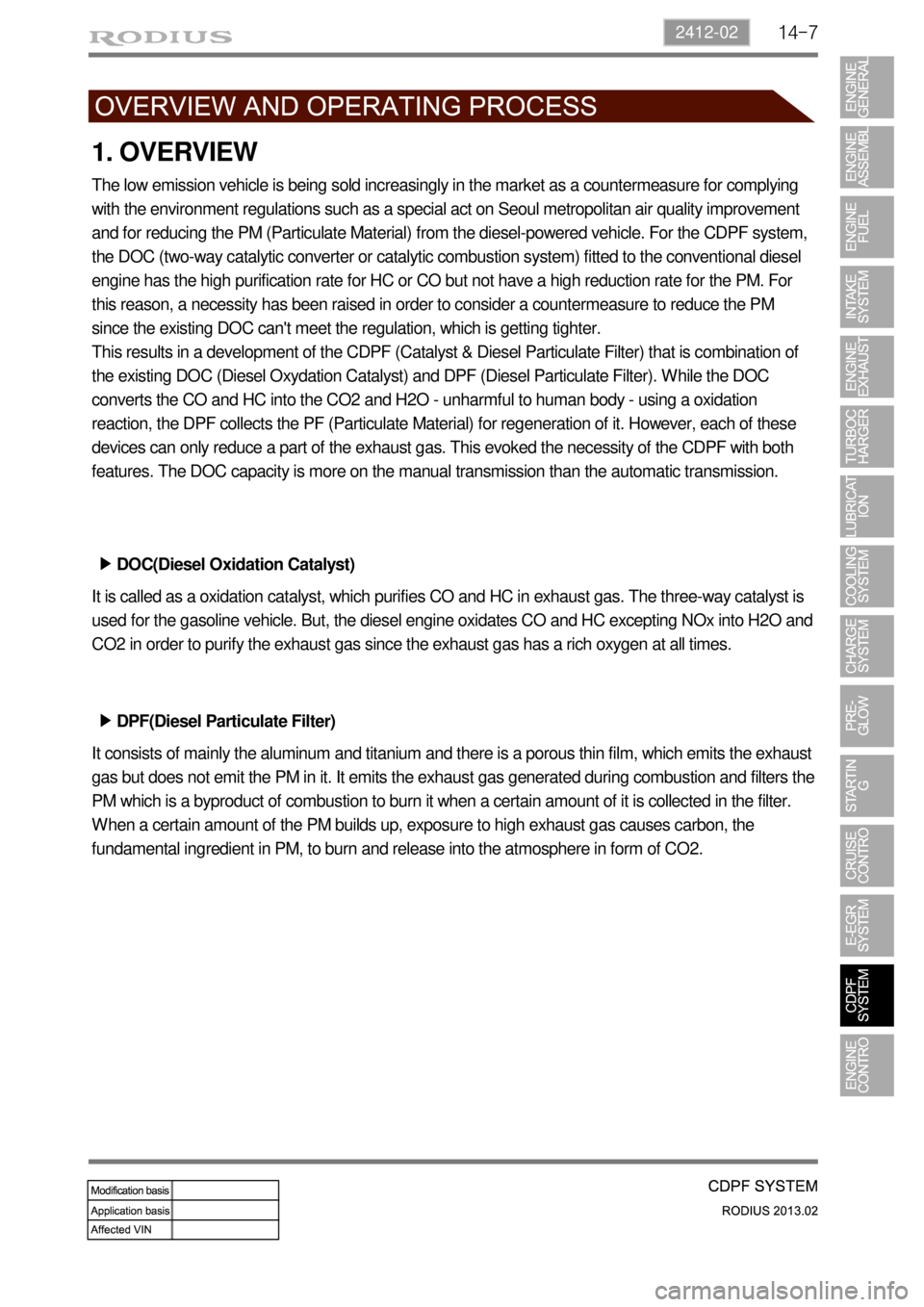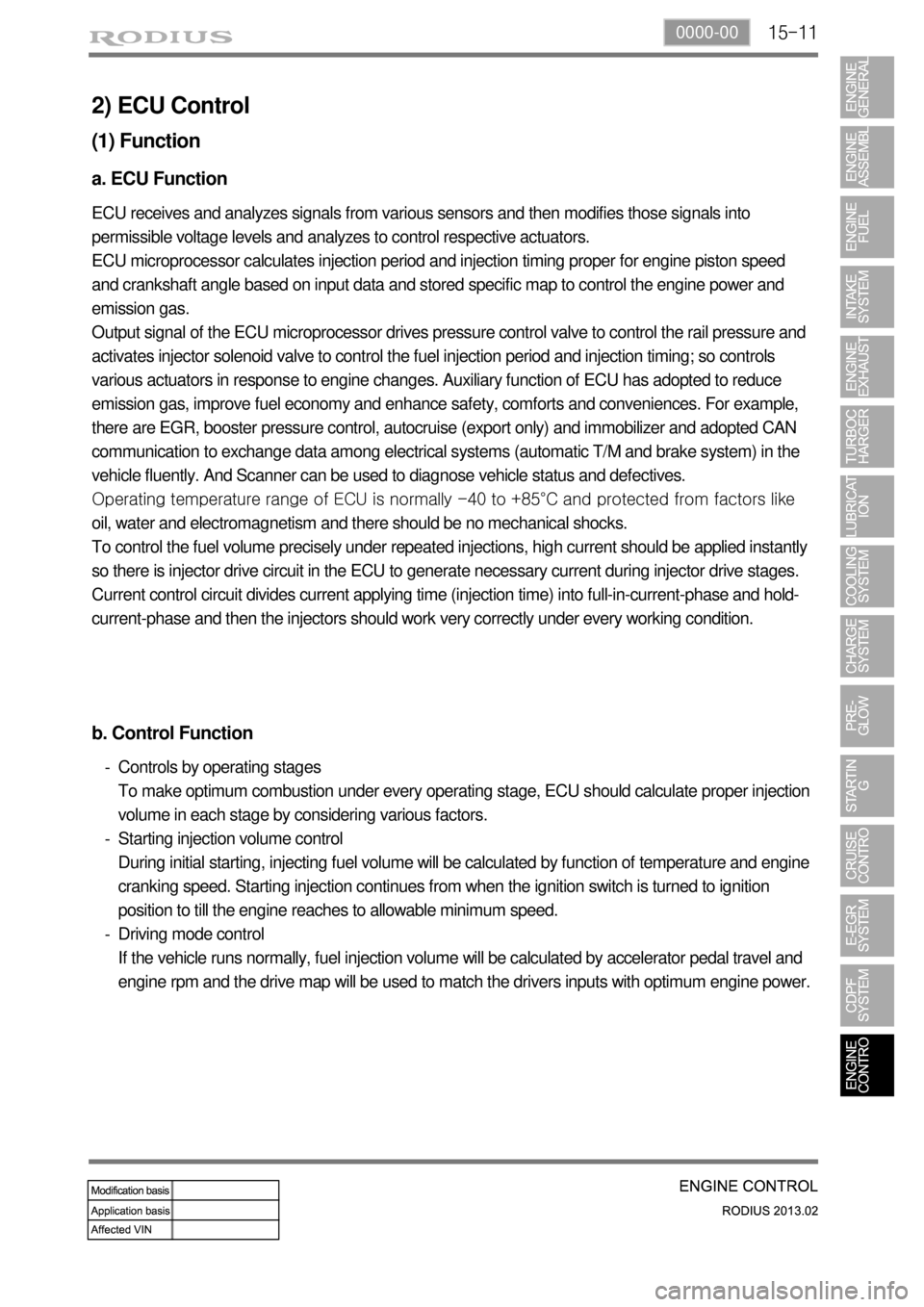Page 174 of 796
02-150000-00
The strut type tensioner automatically adjusts the belt tension to provide the reliability and durability for
the system. And, the belt tension is decreased to minimize the friction loss and improve the belt
operating noise.
1) Crankshaft Pulley (Isolation Damper)
(1) Overview
(2) Sectional drawing
Axial & radial bearing
Sleeve
Hub
Isolation pulley rubber Pulley
Damper rubber
Inertia ring
Page 176 of 796
02-170000-00
2) Belt Tensioner
(1) Overview
The torque deviation from crankshaft affects the components in belt drive system and the belt
movement. The auto tensioner system is to adjust this deviation automatically.
In D20DTR engine, one of the mechanical tensioner, pivot damped tensioner is used to keep the
damping force, system reliability and durability. The single belt drive system needs to use the automati
c
belt tensioning device to transfer the power to pulleys effectively. To get this, the tensioner uses the
spring and damping unit.
(2) Location
Belt tensioner
Page 187 of 796
02-28
3) Valve Assembly (Installed in Cylinder Head)
(1) Features
Automatic valve clearance adjuster by hydraulic pressure (Maintenance Free) - Hydraulic lash
Optimized adjustment of valve clearance reduces the valve noise.
Roller type finger follower reduces the friction loss.
Vertical installation.
Simple and compact design reduces the moving operation (improving valve following and fuel
consumption at high speed) 1.
2.
3.
4.
5.
(2) Arrangement
Hydraulic lash adjuster
Upper valve spring retainer
Lower valve spring retainer
Valve spring
Exhaust valveIntake valve
Finger follower
Page 284 of 796

09-8
(3) Starting with jumper cable
If the battery is weak or terminated, the battery from another vehicle can be used with jumper
cables to start the engine.
Connecting order ▶
The positive (+) terminal of the discharged battery
The positive (+) terminal of the booster battery
The negative (-) terminal of the booster battery
Connect one end of the other jumper cable to the body of the discharged vehicle, such as the
engine block or a front towing hook. 1.
2.
3.
4.
Starting ▶
Prepare a set of jumper cables.
Place another vehicle that has the same 12 V of power near to the discharged vehicle.
Switch off all electrical accessories for the discharged vehicle.
Apply the parking brake and shift the transaxle to the P position (automatic transaxle) or neutral (N)
position (manual transaxle).
Connect the jumper cables.
Try to start the discharged vehicle while accelerating the engine rpm in the booster vehicle.
Attempt to start the engine with the discharged battery.
After starting the engine, carefully disconnect the jumper cables in the reverse sequence of
connection. 1.
2.
3.
4.
5.
6.
7.
8.
Page 302 of 796
12-38510-23
1. CRUISE CONTROL SWITCH
The cruise control is an automatic speed control system that maintains a desired driving speed without
using the accelerator pedal.
The vehicle speed must be greater than 36 km/h to engage the cruise control. This feature is
especially useful for motorway driving.
The cruise control system is a supplementary system, which helps the driver to drive the vehicle at
a desired speed without using the accelerator pedal under the traffic condition where the vehicle-to-
vehicle distance meets the legal requirement.
Page 309 of 796

12-10
(2) Using the Cruise Control on Hills
How well the cruise control works on hills depends on the speed, load, and the steepness of the hill.
When going up steep hills, you may have to depress the accelerator pedal to maintain your speed.
When going downhill, you may have to brake or shift to a lower gear to keep your speed down.
Applying the brake takes you out of the cruise control.
And the cruise control system cannot be operated again in driving state. In this case, you should stop
the vehicle, and turn off the ignition switch and then turn it on again. After you do that, you can use the
cruise control s
ystem again. But if the cruise control system isn’t recovered, you should contact
a Ssangyong Dealer for diagnosis of the cruise control system.
Abnormal changes of the gear selector lever can damage the engine. Do not move the gear shift
lever to Neutral while driving at the set speed. Automatic transmission damage may result.
The speed that has been set may not be maintained on uphill or downhill slopes.
The speed may drop to less than the set speed on a steep uphill grade. The accelerator must be
used if you want to maintain that speed.
The speed may increase to more than the set speed on a steep downhill grade. When the speed
increases too much, turn off the cruise control. -
-
-
-
(1) Abnormal Cancellation of the Cruise Control
When the rapid deceleration is applied without braking.
When the rapid acceleration is applied without acceleration pedal intervention.
When the cruise control lever is failed.
When the brake switch and the brake light switch input signal are implausible. 1.
2.
3.
4.
Page 319 of 796

14-72412-02
1. OVERVIEW
The low emission vehicle is being sold increasingly in the market as a countermeasure for complying
with the environment regulations such as a special act on Seoul metropolitan air quality improvement
and for reducing the PM (Particulate Material) from the diesel-powered vehicle. For the CDPF system,
the DOC (two-way catalytic converter or catalytic combustion system) fitted to the conventional diesel
engine has the high purification rate for HC or CO but not have a high reduction rate for the PM. For
this reason, a necessity has been raised in order to consider a countermeasure to reduce the PM
since the existing DOC can't meet the regulation, which is getting tighter.
This results in a development of the CDPF (Catalyst & Diesel Particulate Filter) that is combination of
the existing DOC (Diesel Oxydation Catalyst) and DPF (Diesel Particulate Filter). While the DOC
converts the CO and HC into the CO2 and H2O - unharmful to human body - using a oxidation
reaction, the DPF collects the PF (Particulate Material) for regeneration of it. However, each of these
devices can only reduce a part of the exhaust gas. This evoked the necessity of the CDPF with both
features. The DOC capacity is more on the manual transmission than the automatic transmission.
DOC(Diesel Oxidation Catalyst) ▶
It is called as a oxidation catalyst, which purifies CO and HC in exhaust gas. The three-way catalyst is
used for the gasoline vehicle. But, the diesel engine oxidates CO and HC excepting NOx into H2O and
CO2 in order to purify the exhaust gas since the exhaust gas has a rich oxygen at all times.
DPF(Diesel Particulate Filter) ▶
It consists of mainly the aluminum and titanium and there is a porous thin film, which emits the exhaust
gas but does not emit the PM in it. It emits the exhaust gas generated during combustion and filters the
PM which is a byproduct of combustion to burn it when a certain amount of it is collected in the filter.
When a certain amount of the PM builds up, exposure to high exhaust gas causes carbon, the
fundamental ingredient in PM, to burn and release into the atmosphere in form of CO2.
Page 339 of 796

15-110000-00
2) ECU Control
(1) Function
a. ECU Function
ECU receives and analyzes signals from various sensors and then modifies those signals into
permissible voltage levels and analyzes to control respective actuators.
ECU microprocessor calculates injection period and injection timing proper for engine piston speed
and crankshaft angle based on input data and stored specific map to control the engine power and
emission gas.
Output signal of the ECU microprocessor drives pressure control valve to control the rail pressure and
activates injector solenoid valve to control the fuel injection period and injection timing; so controls
various actuators in response to engine changes. Auxiliary function of ECU has adopted to reduce
emission gas, improve fuel economy and enhance safety, comforts and conveniences. For example,
there are EGR, booster pressure control, autocruise (export only) and immobilizer and adopted CAN
communication to exchange data among electrical systems (automatic T/M and brake system) in the
vehicle fluently. And Scanner can be used to diagnose vehicle status and defectives.
Operating temperature range of ECU is normally -40 to +85°C and protected from factors like
oil, water and electromagnetism and there should be no mechanical shocks.
To control the fuel volume precisely under repeated injections, high current should be applied instantly
so there is injector drive circuit in the ECU to generate necessary current during injector drive stages.
Current control circuit divides current applying time (injection time) into full-in-current-phase and hold-
current-phase and then the injectors should work very correctly under every working condition.
b. Control Function
Controls by operating stages
To make optimum combustion under every operating stage, ECU should calculate proper injection
volume in each stage by considering various factors.
Starting injection volume control
During initial starting, injecting fuel volume will be calculated by function of temperature and engine
cranking speed. Starting injection continues from when the ignition switch is turned to ignition
position to till the engine reaches to allowable minimum speed.
Driving mode control
If the vehicle runs normally, fuel injection volume will be calculated by accelerator pedal travel and
engine rpm and the drive map will be used to match the drivers inputs with optimum engine power. -
-
-